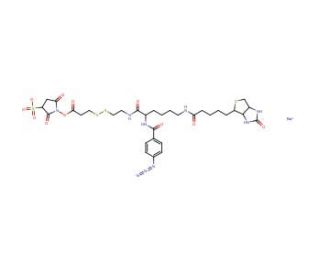用法 :
Important Product information
• Do not store Sulfo-SBED in solution because the NHS ester will hydrolyze and become non-reactive. The half-life of the NHS ester moiety is ~20 minutes in phosphate buffer at room temperature. Discard any unused reconstituted crosslinker.
• Sulfo-SBED is soluble in DMSO (125mM), DMF (170mM), methanol (12mM) and water (~5mM). The concentration of Sulfo-SBED may vary from 0.1 to 3mM in most buffers (~1mM in 0.1M PBS). To solubilize Sulfo-SBED at higher concentrations, first dissolve it in a water-miscible organic solvent such as DMSO or DMF. Use 1-10% of solvent in the final reaction volume to minimize detrimental effects to the protein.
• Gently mix the solution with a pipette tip to fully reconstitute the reagent. Use the Sulfo-SBED solution immediately. Discard any unused reconstituted Sulfo-SBED.
• For the Sulfo-NHS ester coupling reaction, any buffer at pH 7-9 may be used provided it does not contain primary amines or sulfhydryls (e.g., phosphate, borate, carbonate and HEPES are acceptable buffers).
• Proteins modified with Sulfo-SBED may precipitate in solution at concentrations lower than expected. If a precipitate forms in the final conjugate, dilute conjugate before use if possible. For some applications it may be necessary to filter the conjugate before use.
• The disulfide bond of Sulfo-SBED may be cleaved by dithiothreitol or 2-mercaptoethanol, resulting in a biotin label attached to the protein conjugated by photoactivation. The biotinylated protein then may be used in such applications as immobilization of the protein, protein purification or an immunoassay.
Procedure for Coupling Trypsin and Soybean Trypsin Inhibitor with Sulfo-SBED
The following procedure is an example application for Sulfo-SBED. In this procedure, the primary amines on the soybean trypsin inhibitor (STI) are modified at 4-25°C in the dark. After removal of hydrolyzed and non-reacted crosslinker by gel filtration or dialysis, the modified protein then can be coupled by photoactivation to trypsin.
A. Materials Required
• ~5mg of Trypsin Inhibitor, soybean (STI)
• Phosphate Buffered Saline
• DMSO or DMF
• Desalting Columns or other product for buffer exchange.
• TPCK Trypsin
• 50mM DTT or 100mM β-Mercaptoethanol
B. NHS-Ester Reaction
Note: Perform Steps 1-4 in the dark to preserve the aryl azide group.
1. Dissolve ~5mg of Trypsin Inhibitor, soybean (STI) in 0.5mL PBS in a microcentrifuge tube.
2. Immediately before use, dissolve 1.12mg of Sulfo-SBED in 25µL of DMSO or DMF. Add 11µL of the Sulfo-SBED solution to the STI.
3. Incubate at room temperature for 30 minutes or on ice for 2 hours. If a precipitate forms, centrifuge briefly (~1 minute) to remove hydrolyzed Sulfo-SBED from the solution.
4. Taking care to avoid the pellet, apply the reaction mixture to a 5mL desalting column equilibrated with PBS to remove the balance of the non-reacted Sulfo-SBED. Alternatively, use dialysis to remove the nonreacted Sulfo-SBED.
C. Conjugation of Biotinylated STI with Trypsin
1. Mix biotinylated STI with 5mg of TPCK Trypsin dissolved in 0.5mL of PBS. Incubate at room temperature for 3 to 5 minutes.
2. Photoactivate the aryl azide using a long-wave UV lamp (365nm) at a distance of 5cm for 15 minutes.
3. Desalt using a 10mL desalting column equilibrated with PBS. Collect 1mL fractions and pool protein-containing fractions.
4. The disulfide bond in the spacer arm originally attached to the Sulfo-NHS ester may be cleaved by incubating with 50mM DTT or 100mM β-Mercaptoethanol.
Additional Information
A. Determination of Biotin Incorporation
Biotin incorporation can be estimated using the HABA (4′-hydroxyazobenzene-2-carboxylic acid] method. This method is based on the ability of the HABA dye to bind avidin forming a complex with maximal absorption at 500nm. Biotin is then added to the solution and because of its higher affinity for avidin, biotin displaces the HABA and the absorption at 500nm decreases proportionately. The absorbance of the HABA-avidin solution is measured before and after adding the biotin-containing sample. The change in absorbance relates to the amount of biotin in the sample.


